(aka BAJO EL VESTIDO, NADA)
(1985,Italy)

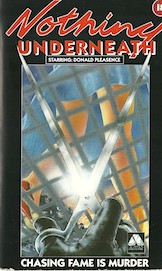

[review by JA Kerswell]
NOTHING UNDERNEATH was one of the few gialli from the mid-1980s that struck a chord with Italian cinema-goers and was a bone-fide box office hit in its home country (albeit a controversial one in certain circles). It’s easy to see why, with its blend of intrigue, fashion and demented lunacy. In other words, the perfect combination for a heady Italian slasher thriller - and arguably one of the last great gialli.
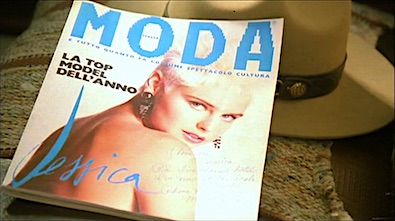 |
|
| Model on the cover of a magazine ... |
I’ve said many times before, but one of my favourite trash aesthetics is pitting models against monsters - or, in this case, a scissor wielding serial killer. It’s a concept for the ages, and one that has been recycled many times by Italian film-makers since Mario Bava set the template with his seminal BLOOD AND BLACK LACE (1964). Director Carlo Vanzina brings the concept into the mid-1980s (before the giallo tipped into its neon and dry ice phase) with a sly dig at the vapid nature of the fashion industry. The film’s title refers not just to the fact that the models don’t wear underwear (as illustrated numerous times throughout - the Italian title is even more literal, translating as 'Under the Dress Nothing'), but also that little of substance really lies beneath the gold stitching and Armani sunglasses. The vapidness most obvious in the horribly outdated scene where all the models are swamped head-to-toe in real fur. Most of the classic era gialli of the 1970s were populated with gorgeous, but morally numb - and often socio or plain psychopathic - characters. To his credit, whilst there’s a fair share of those in NOTHING UNDERNEATH, Vanzina also adds a handful of likeable and relatable players.
By the mid-1980s, many Italian film-makers had their eyes on the US market as opportunities began to dry up back home. Ruggero Deodato and Umberto Lenzi were among the directors who tailored product for US audiences around this time - and also filmed in the States. Vanzina does a bait-and-switch here in that regard. NOTHING UNDERNEATH starts with veritable All Americana, as we are introduced to the film’s central character: Bob (Tom Schanley), a handsome, blue-eyed wildlife ranger in Yellowstone Park. His twin sister Jessica Crane (Nicola Perring) - a probable nod to Marion Crane’s ill-fated would-be protagonist in Hitchcock’s PSYCHO (1960) - is a top model in Milan, Italy. He proudly shows off her magazine front covers to the locals: “We’re not talking Penthouse here, she’s got clothes on!”
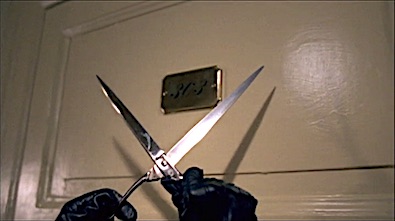 |
|
| A killer strikes in the hotel of supermodels! |
Vanzina throws in his first sidewinder, when Bob appears to ‘feel’ Jessica’s trauma via a psychic link that spans the Atlantic Ocean and manifests itself in psychical pain. The telepathy angle would likely have been avoided by most giallo makers in the 1970s, but coincidentally it was a theme explored by Dario Argento the same year with PHENOMENA (he had previously touched upon it with DEEP RED (1975)). Bob has startling visions that Jessica is in immediate danger from a mystery assailant wielding giant scissors - and he desperately tries to warn her. However, when the concierge of the hotel eventually goes to check on her, he finds her suite unoccupied and Jessica nowhere to be found.
With no word from his sister, and convinced that she has come to harm, Bob jumps on the next plane to Milan. There he tries to find out what’s happened by talking to her fellow models, including a seemingly sympathetic Danish girl (Renée Simonsen - at the time 19 years old, one of the highest paid models in the world and the girlfriend of Duran Duran’s John Taylor) and the last photographer who worked with her (Philip Wong). He stays at the hotel where Jessica vanished, and where all the top models stay (and one chooses to masturbate with her curtains open!). He also tries to convince the police to open a case. He tells Commissioner Danesi (Donald Pleasance sporting a rather unconvincing Italian accent): “I saw the weapon: a pair of scissors. And I saw the blood, but I couldn’t see the killer’s face.” Perhaps surprisingly, Danesi appears to to believe Bob’s claims of a psychic link with his twin sister soon after meeting him. The stakes are raised, however, when another model is found murdered at the same hotel …
 |
|
| Bob (Tom Schanley) and Commissioner Danesi (Donald Pleasance) discuss the case - in a, at the time in Italy, new concept - fast food restaurant. |
Tom Schanley makes for an engaging lead (and he’s actually prettier than most of the models in the film!). Apart from the added flavour of telepathy he is the archetypal giallo protagonist, who turns to amateur sleuthing to uncover the truth about what happened to his sister. It’s here where Vanzina revels in the grime beneath the glitz, as he discovers that, in Jessica’s case, all that glitters was not gold. Paradoxically, NOTHING UNDERNEATH also revels in the glamour of the very industry it is criticising. The film is handsomely shot and benefits from beautifully fluid camera-work. Vanzina is a talented enough director, however, to not grind the action to a halt whilst wallowing in these excesses. A runway set piece and stand off between a model and the police - set to Gloria Gaynor’s I Am What I Am and Murray Head's One Night in Bangkok - propels the story forward and climaxes in yet another murder. The paradox continues, with Vanzina perhaps commenting on models as just meat for the grinder - both to the killer and the industry. In one scene the models themselves also appear to place so little value on their own lives that one of them quite literally throws hers away for the chance of some cash. There’s a surprising amount of casual nudity and, as said before, the film justifies its title with several gratuitous shots; including a variation on Marilyn Monroe's billowing skirt in THE SEVEN YEAR ITCH (1955). However, the film does not feel particularly sleazy. Despite its evident cynicism it’s a fun ride, with continuous twists and turns towards its show-stopper slo-mo climax complete with the killer brandishing a power drill. Vanzina throws in everything from mysterious pouches of diamonds to copious cocaine use to a fatal game of Russian Roulette. It’s an irresistible mix for any fan of the giallo topped off with a hard-to-guess killer with a memorably bonkers motivation and shattering denouement.
The entertainment value is upped by the nod-and-winks the director throws to the audience. Much in the way Dario Argento did in his classic gialli, Vanzina uses humour to flavour the proceedings, but never in an overbearing way. Indeed, Vanzina and his brother Carlo had made their names with highly popular comedies previously. One scene has the concierge of the hotel (comedic actor Mimmo Sepe) offering words of comfort to the assorted crowd as the paramedics carry out yet another deceased model covered in a white sheet: “Her last dress ... Her last show.” Pleasance takes his clichéd role (wouldn’t you know it, but he’s up for retirement and only has 15 days left on the job) and has fun with it. As ever, his presence is a welcome bonus. He says to Bob - who he nicknames Wyoming: “I’m going to find your sister. Dead or Alive. Hopefully the latter!” Of eating at a fast food restaurant he bemoans the ketchup: “I’ve never much cared for sauces the colour of blood.”
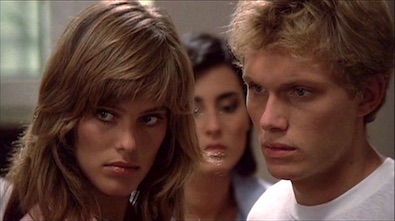 |
|
| The bodies - and the suspects - multiply. Real-life Danish supermodel Renée Simonsen and Tom Schanley. |
Vanzina had made the earlier giallo MYSTERE in 1983 (a minor hit in Italy, but a bust with critics) and would go on to make SQUILLO (1996). The versatile director (he’s still working today in many different genres) co-wrote the script with his bother Carlo and Franco Ferrini (whose outstanding giallo pedigree began with RINGS OF FEAR (1978) and included many Argento collaborations from PHENOMENA (also 1985) to DO YOU LIKE HITCHCOCK? (2005)). Although, reportedly, Argento did not care for this film. NOTHING UNDERNEATH was ostensibly adapted from the scandalous 1983 giallo novel by Marco Parma; although Vanzina boasted that the only thing they kept from Parma’s book was its first page, thriller intent and title. Rather, he said it’s main inspiration was Irvin Kershner’s THE EYES OF LAURA MARS (1978) and Brian De Palma’s BODY DOUBLE (which had been a big hit in Italy the previous year - with Vanzina even going as far as to also use Pino Donaggio’s music, as well as utilising a power drill in a key scene). It seems likely that the twin’s telepathy was also inspired by De Palma’s earlier THE FURY (1978). At the time of its release, Vanzina also name-checked Sergio Pastore’s delightfully loopy model murderthon THE CRIMES OF THE BLACK CAT (1972), suggesting he was well versed in giallo heritage. Ferrini also took inspiration from a true crime case that had scandalised Milan the previous year, when a cocaine-fuelled, 26 year old North American model named Terry Broome had murdered a playboy who had been accused of stalking and intimidating her. It was a case that made Milan’s fashion industry even more touchy.
Intriguingly, director Michelangelo Antonioni had previously optioned NOTHING UNDERNEATH and had written a screenplay according to Vanzina. Antonioni had, of course, made his own quasi giallo BLOW UP (1966) - which had also revolved the world of fashion in then swinging London and starred David Hemmings, who would go on to star in Argento’s DEEP RED. Vanzina postulated that Antonio’s script too closely followed Parma’s book, which was apparently much more scathing; shocking the fashion industry and raising the ire of many. Whilst the inherent criticism of the shallowness of the fashion industry remains, Vanzina was less interested in social commentary and more in making entertainment where the main element is the whodunnit. He said at the time of its release: “The only thing necessary for the viewer is to find the killer.” Aware of commerciality and the changing times, he likened his film to a rock movie - or more aptly a pop video. An approach that was to become prevalent as subsequent directors attempted replicate the financial success of this film (despite sniffy reviews at home it was the 22nd highest grossing film in Italy in 1985 - for comparison Lamberto Bava’s today more celebrated DEMONS was the 42nd).
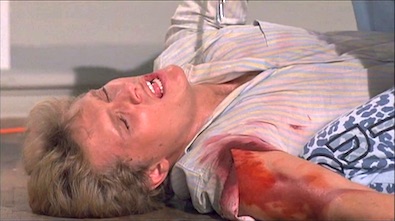 |
|
| NOTHING UNDERNEATH culminates in a driller killer thriller! |
Such was the negative perception of the source novel by the fashion world, that only one Italian designer allowed his work to be featured in the film - the irreverant Franco Moschino - whose runway played a major role in one of its main set pieces. Having only been created two years earlier, Moschino was rewarded with major publicity when the film proved to be a hit. The fact that none of the other Milanese fashion houses would participate was exploited for publicity purposes by the film makers. At the premiere of NOTHING UNDERNEATH, seats were reserved for the likes of Armani, Krizia, Versace and Ferrè - but none turned up. This drove the Italian press into a frenzy (one headline screamed: “Milan fashion trembles!”) and was a publicity dream for the film - but it was a clever ruse (orchestrated by Enrico Lucherini, at the time Vanzina's press officer), as none of the fashion houses had actually been invited!
Perhaps unsurprisingly, a sequel - if in name only - appeared in 1988. Dario Piana’s NOTHING UNDERNEATH 2 (released elsewhere as TOO BEAUTIFUL TO DIE) in reality just took the theme of models vs psychos, but was entertaining enough on its own terms. It was also moderately successful, scoring 38th highest grossing film at the Italian box office on its release. Vanzina returned to the subject matter in 2011 with the widely panned, commercial failure NOTHING UNDERNEATH: THE LAST SHOW.
NOTHING UNDERNEATH is by no means perfect. Vanzina is more than able during the suspense sequences - evidenced by a tense chase through the deserted streets of Milan - but the film could have benefited from more sequences like this and perhaps a touch more blood. The telepathy angle does, at times, stretch credulity and it could be argued that it’s a bit of a cop out to patch over plot holes (especially how Bob finally tracks down Jessica). However, the pluses more than outweigh these concerns - and it remains highly recommended to any giallo fan.
BODYCOUNT 5  female: 5 / male: 0
female: 5 / male: 0
1) Female killed (off-screen)
2) Female stabbed to death with scissors (off-screen)
3) Female stabbed in the back with scissors
4) Female smothered with a pillow and cut with knife
5) Female shoots her self in head
6) Female falls to her death